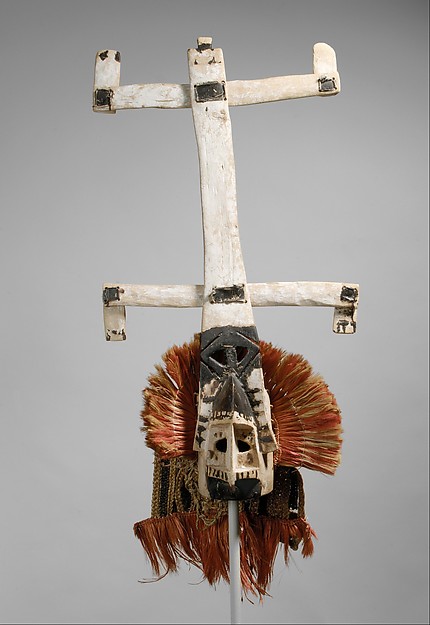
Mask (Kanaga), Mali, Dogon peoples, 20th century, wood, fiber, hide, pigment, 53.6 x 97.2 x 15.9 cm (The Metropolitan Museum of Art)
Dogon masks, such as this one called kanaga, are worn primarily at dama, a collective funerary rite for Dogon men. The ritual’s goal is to ensure the safe passage of the spirits of the deceased to the world of the ancestors. The ceremony is organized by members of Awa, a male initiation society with ritual and political roles within Dogon society. As part of the public rites related to death and remembrance, Awa society members are responsible for the creation and performance of the masks.
Like other Dogon wooden masks, kanaga masks depict the face as a rectangular box with deeply hollowed channels for the eyes. The superstructure above the face identifies this mask as a kanaga: a double-barred cross with short vertical elements projecting from the ends of the horizontal bars. This abstract form has been interpreted on two levels: literally, as a representation of a bird, and, on a more esoteric level, as a symbol of the creative force of god and the arrangement of the universe. In the latter interpretation, the upper crossbar represents the sky and the lower one, the earth.
This kanaga mask was collected complete with some of its costume elements. Attached to the wooden face mask is a hood composed of plaited fiber strips dyed black and yellow with a short fiber fringe that covers the dancer’s head. A ruff of red and yellow fibers frames the face. The dancer also wore a black vest woven of fiber and embroidered with white cowry shells and fiber armbands at the wrists and elbows. This ensemble included a long skirt of loosely strung, curly black fibers and a short overskirt composed of straight red and yellow fibers, worn over trousers.
More than eighty different types of masks, of both wood and fiber, have been documented in dama performances. They represent various human characters familiar to the Dogon community, such as hunters, warriors, healers, women, and people from neighboring ethnic groups. The masks may also depict animals, birds, objects, and abstract concepts.
Because preparations are elaborate and costly, the dama may be held several years after the death and burial of an individual. Performances take place over a six-day period, culminating with a procession of masked dancers who escort the souls of the dead from the village, where they might cause harm, to their final resting place in the spiritual realm. The ceremony recalls the origins of the Dogon people, while also marking the end of the mourning period for the recently deceased. Today, such masks continue to be worn at dama performances but are also danced on other, more secular occasions, such as national holidays and as demonstrations organized for the benefit of tourists.
© 2006 The Metropolitan Museum of Art, New York (by permission)

